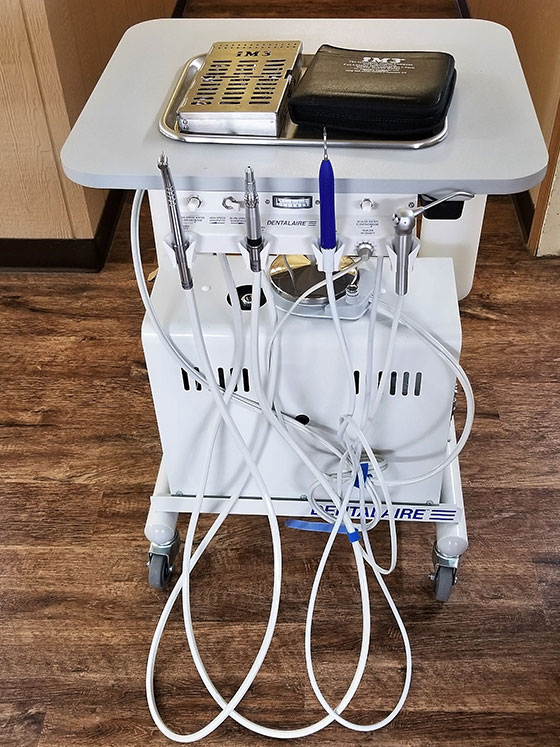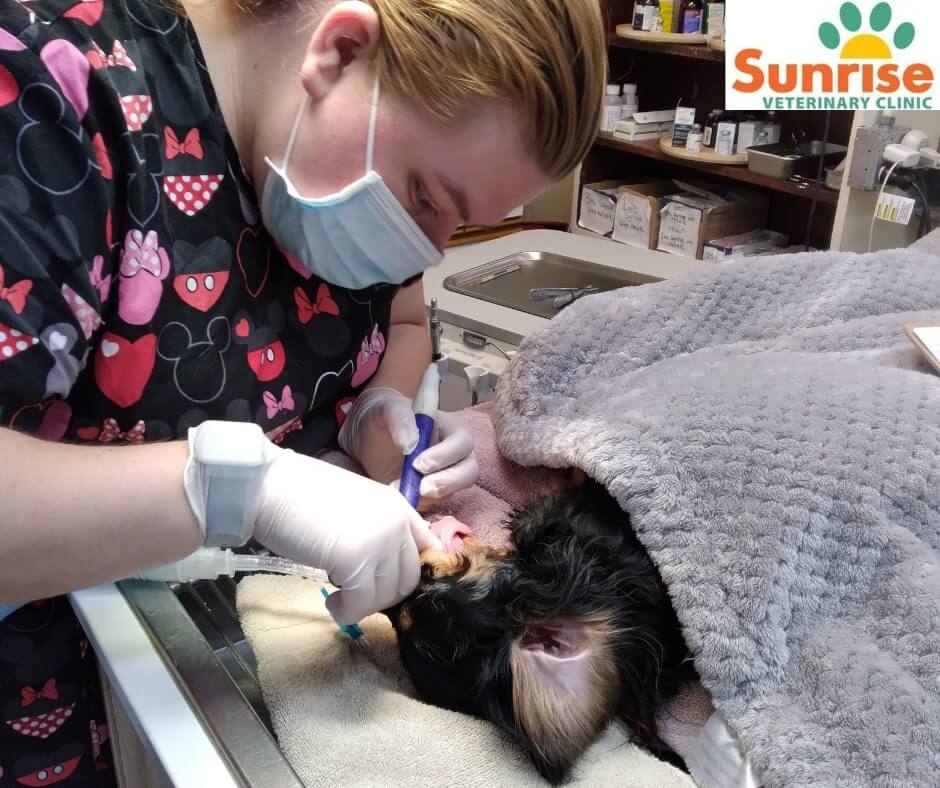Pet Dental Care In Benton City, WA
Your pet’s oral care is essential for their overall health.
Regular dental care is an important part of your pet’s health!
If left untreated, periodontal disease can cause chronic pain and infections of the heart, liver, and kidneys. Periodontal disease and it’s consequences can be avoided by having regular dental checkups and dental procedures. Our dental service includes a full physical examination, intra-oral examination under general anesthesia, intraoral radiology, periodontal probing, charting, ultrasonic cleaning and polishing, and extractions when needed. Our patients are closely monitored by a Licensed Veterinary Technician throughout the procedure.
Comfort is always our top priority! Our patient pictured below is recovering from his dental procedure and extractions snuggled up and on a temperature controlled veterinary warming device.

Frequently Asked Questions about pet dental health:
Do you have to put my pet under using anesthesia to perform dental work?
In order for us to appropriately diagnose and treat your pet’s oral disease, general anesthesia is necessary. Safety is our number one priority. The proper administration of pain medication before, during and after your pet’s surgery can reduce the pain and anxiety associated with the procedure. The doctor will design an individualized anesthesia protocol based upon the results of pre-operative laboratory tests, the specific oral disease being treated in your pet, and any concomitant health conditions (i.e., heart, kidney or liver disease) your pet may have. An appropriately designed, administered and monitored anesthesia protocol can dramatically decrease the risk associated with anesthesia. The very latest in technology is used for patient monitoring under anesthesia. A trained veterinary staff member continuously monitors the anesthesia while the doctor or licensed veterinary technician (nurse) is working on your pet. To maintain your pet’s body temperature under anesthesia, all patients are placed on a ChillBuster Veterinary Warming Device. By maintaining a normal temperature under anesthesia, your pet’s recovery is improved and postoperative complications are minimized. All patients receive an intravenous catheter and fluids under anesthesia. Patients receiving general anesthesia are intubated with an endotracheal tube to secure their airway and to prevent the aspiration of water used during the dental procedure.
Our dog has a fractured tooth and doesn’t seem bothered by it, do we really need to have it treated?
Yes, especially if the internal portion of the tooth or pulp is involved. The pulp of the tooth contains the blood vessels and nerves of the tooth. Teeth with pulp exposure are painful. When the pulp of a tooth is exposed, bacteria can enter into the tooth and infect the pulp. Often, there are no notable outward symptoms (facial swelling) until very late in the course of the infection. Because the infection is localized at the root tip (tooth root abscess), and since the tooth root is hidden from view within the jaw bone, the classic sign of facial swelling is not seen until the infection has worked its way through the jaw bone overlying the root.
Is dental scaling performed on animals without anesthesia a suitable alternative to professional periodontal therapy?
Animals usually do not receive the same level of at-home dental hygiene (brushing and flossing) we do, and as a result, adult pets often have established periodontal disease. In some of these pets, especially older pets, periodontal disease has progressed beyond its early or mild stages (gingivitis). The moderate and severe stages of periodontal disease traditionally require various therapies (periodontal and oral surgery) in addition to dental scaling.
When scaling is used as a standalone treatment to address all stages of periodontal disease, especially when used as a monotherapy for the treatment of severe periodontal disease, it is purely cosmetic and non-therapeutic. Pet owners naturally are concerned when anesthesia is required for their pet. However, performing dental scaling on an unanesthetized pet is inappropriate for the following reasons:
1. Dental tartar is firmly adhered to the surface of the teeth. Scaling to remove tartar is accomplished using ultrasonic and sonic power scalers, plus hand instruments that must have a sharp working edge to be used effectively. Even slight head movement by the patient could result in injury to the oral tissues of the patient, and the operator may be bitten when the patient reacts.
2. Professional dental scaling includes scaling the surfaces of the teeth both above and below the gingival margin (gum line), followed by dental polishing. The most critical part of a dental scaling procedure is scaling the tooth surfaces that are within the gingival pocket (the subgingival space between the gum and the root), where periodontal disease is active. Because the patient cooperates, dental scaling of human teeth performed by a professional trained in the procedures can be completed successfully without anesthesia. However, access to the subgingival area of every tooth is impossible in an unanesthetized canine or feline patient. Removal of dental tartar on the visible surfaces of the teeth has little effect on a pet’s health and provides a false sense of accomplishment. The effect is purely cosmetic.
3. Inhalation anesthesia using a cuffed endotracheal tube provides three important advantages – the cooperation of the patient with a procedure it does not understand, elimination of pain resulting from examination and treatment of affected dental tissues during the procedure, and protection of the airway and lungs from accidental aspiration. The American College of Veterinary Anesthesia and Analgesia (ACVAA) recommends general anesthesia with endotracheal tube intubation for all dental cleanings in dogs and cats.
4. A complete oral examination, which is an important part of a professional dental scaling procedure, is not possible in an unanesthetized patient. The surfaces of the teeth facing the tongue cannot be examined, and areas of disease and discomfort are likely to be missed.
Will my pet be able to eat normally and enjoy treats after having extractions?
When should I start dental care with my pet?
How can I tell if my dog or cat has gum disease or other dental problems?
What is a home dental care program?
How do I brush my pet's teeth at home?
To brush your pet’s teeth you must train your pet gradually over several weeks. Small dogs and cats are most easily done when they are sitting on a table, counter or your lap. Larger dogs can be sitting on the floor.
Especially when you first begin, it may take two people to get the job done, but be careful not to over-restrain your pet — keep brushing sessions short and positive. One person can hold your pet and the other can actually do the brushing. Praise and reassure your pet throughout the process, and don’t forget to provide a treat or reward afterwards!
Here is an example of how to get your pet used to having their teeth brushed gradually:
Step 1: Dab a bit of flavored toothpaste from your local pet store (typically these come in flavors like chicken or beef). Don’t use toothpaste designed for humans because it could upset your pet’s stomach. Rub the “flavored” finger gently over the pet’s mouth and teeth. Make the initial sessions short and positive.
Step 2: Gradually, introduce gauze over the finger and gently scrub the teeth and gums in a circular motion.
Step 3: Finally, you can introduce a soft toothbrush designed for pets. Special pet toothbrushes are available from your veterinarian or at pet stores.
If your pet won’t cooperate with home brushing or if you already see brown tartar stains on its teeth or red and bleeding gums, it’s time to turn to your veterinary dentist for help. Your pet will be given general anesthesia and have their teeth cleaned above and below the gum line to remove plaque and tartar. After the teeth are cleaned, they will be polished to remove microscopic plaque and to make the teeth smooth to discourage plaque from clinging. Remember, dental care is as important to your pet’s health as it is to your own. You owe it to your pet to provide regular dental care and cleaning.
How often should I brush my pet’s teeth?
Ideally, you should brush your pet’s teeth daily. Brushing less frequently than three times per week is not productive and other methods of decreasing plaque and tartar accumulation should be used such as specially-designed dental diets, treats, barrier sealants, antiseptic rinses, gels and water additives.
How many teeth do dogs and cats have?
Dogs start out with 28 deciduous (baby) teeth, cats start out with 26 deciduous teeth. By six months of age, these baby teeth fall out and are replaced by permanent teeth, 42 in the dog and 30 in the cat.
Are there certain diets and treats that can improve the health of my pet’s teeth?
Specially-designed dental diets and treats can help to retard plaque and tartar build-up between your pet’s dental cleanings and may even extend the interval between cleanings. Not all products with a dental claim on their label, however, are efficacious and it is important to be an informed consumer of veterinary dental products. An independent organization, the Veterinary Oral Health Council (VOHC), awards a Seal of Acceptance to veterinary dental diets and products that meet a pre-set standard in plaque and tartar reduction in animals. A listing of products awarded the seal is available on the VOHC website,vohc.org.





